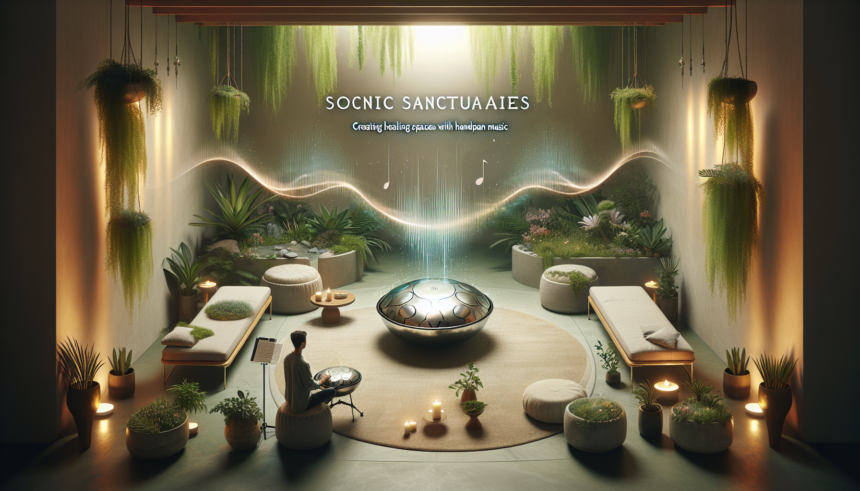In an ever-accelerating world, the need for spaces dedicated to reflection and healing has never been greater. Music, as a universal language, offers a sanctuary where one can experience reprieve. Among the various instruments used in creating these healing spaces, the handpan stands out as a particularly evocative and effective medium. Originally developed in the early 2000s, the handpan has an ethereal quality that captivates listeners, making it an ideal candidate for sonic sanctuaries—spaces specifically designed to invoke tranquility and emotional well-being.
Origins of the Handpan
The handpan, also known as the hang drum, was first created by Felix Rohner and Sabina Schärer of PANArt, a Swiss company. The instrument was inspired by the steelpan from Trinidad and Tobago, along with various other percussion instruments from around the world. Its unique, domed shape and subtle, resonant sounds set it apart from other instruments, imbuing it with a mystique that enthralls musicians and audiences alike.
The Science Behind Healing Music
Music therapy has been recognized for its healing properties for centuries, dating back to ancient civilizations. Modern studies have shown that music can influence the autonomic nervous system, reducing stress, lowering blood pressure, and enhancing mood. The specific tones and vibrations created by the handpan can affect brainwave activity, encouraging a state of relaxation or even altering one’s consciousness to achieve deeper levels of meditation.
Creating a Sonic Sanctuary
Choosing the Right Environment
Creating a sonic sanctuary with handpan music begins with selecting an appropriate environment. Ideally, this space should be free from distractions and external noises. A room with good acoustics, perhaps enhanced by soft furnishings, will ensure that the handpan’s rich overtones resonate fully. Nature settings, such as gardens or areas near water, can also serve as excellent locations for handpan music, merging natural sounds with the instrument’s melodies to enhance the experience.
Complementing with Other Elements
Creating a truly immersive environment often involves more than just music. Incorporate elements such as ambient lighting, aromatic oils, and tactile textures to design a multi-sensory experience. Soft lighting or candlelight can create a warm, inviting atmosphere. Essential oils like lavender or eucalyptus, known for their calming properties, can be diffused to enhance the soothing ambiance. Comfortable seating or mats can provide physical relaxation, and tactile elements like textured cushions or blankets can add another layer of sensory engagement.
Guided Sessions
A handpan player can guide sessions by blending structured melodies with improvisational elements. The cyclical, repetitive nature of handpan music allows the listener to surrender to the flow of sounds. This is particularly effective in guided meditation or yoga sessions, where the music acts as a conduit, guiding participants toward a state of deep relaxation and introspection.
Benefits of Handpan Healing Sessions
Mental Health
Handpan music can significantly impact mental health. By engaging with the sounds and vibrations, individuals can experience reduced anxiety, lower levels of depression, and improved mental clarity. The repetitive and soothing nature of the handpan’s tones helps in grounding the mind, making it easier to process emotions and clear mental clutter.
Physical Health
The calming effects of handpan music can extend to physical health as well. Lower stress levels can lead to improved sleep and reduced physical symptoms associated with anxiety and tension, such as headaches and muscle pains. Moreover, the meditative state induced by handpan music can enhance immune function and promote overall well-being.
Spiritual Health
For those seeking spiritual growth, handpan music offers a bridge to transcendental experiences. The harmonics and overtones produced by the handpan can facilitate altered states of consciousness, making it easier to connect with one’s deeper self or a higher power. Rituals and spiritual practices, such as shamanic journeys or deep meditation, can be notably enhanced by the presence of handpan music.
Scientific Studies and Testimonials
Although empirical studies specifically focused on the handpan are still emerging, a growing body of anecdotal evidence supports its effectiveness in promoting well-being. Testimonials from practitioners and participants alike attest to the instrument’s calming influence and transformative potential. Research has shown that music with similar acoustic properties to the handpan can lead to beneficial changes in heart rate variability, cortisol levels, and overall emotional state.
Learning to Play the Handpan
If you find yourself captivated by the idea of handpan music and wish to create your own sonic sanctuaries, learning to play this instrument can be a rewarding endeavor. Unlike many traditional instruments, the handpan is relatively intuitive, making it accessible even for those without formal musical training. Many online tutorials and workshops are available, and finding a local handpan community can also offer support and collaboration opportunities.
Conclusion
Handpan music provides an invaluable tool for creating sonic sanctuaries that foster healing, relaxation, and spiritual growth. By understanding the unique qualities of the handpan, selecting the right environment, and incorporating complementary sensory elements, you can craft a space where both the mind and body can find solace. Whether experienced as a listener or a practitioner, the handpan’s ethereal tones offer a gateway to tranquility and introspection, making it a cherished instrument for anyone seeking refuge from the stresses of modern life.
Frequently Asked Questions
1. What is a handpan?
The handpan is a steel percussion instrument, originally created by Felix Rohner and Sabina Schärer of PANArt in Switzerland. It has a unique, dome-like shape and produces resonant, harmonic tones when struck with the hands.
2. How does handpan music help with relaxation?
Handpan music produces a range of harmonic and overtonal sounds that can influence brainwave activity, promoting relaxation and reducing stress. Its repetitive and soothing melodies help to ground the mind and facilitate meditation.
3. Can I create a sonic sanctuary at home?
Yes, you can create a sonic sanctuary at home by selecting a quiet, comfortable space, incorporating ambient lighting, essential oils, and textured elements, and using handpan music to generate a relaxing atmosphere.
4. Do I need musical training to play the handpan?
No formal musical training is necessary to start playing the handpan. Its intuitive design makes it accessible to beginners, and there are plenty of online resources and workshops to help you learn.
5. What types of practices can be enhanced by handpan music?
Handpan music can enhance various practices such as yoga, guided meditation, shamanic journeys, and other forms of spiritual or therapeutic activities. The calming and transcendent tones facilitate deeper states of relaxation and introspection.





